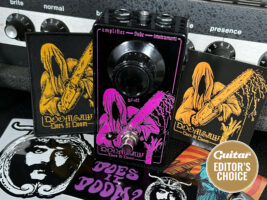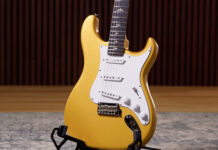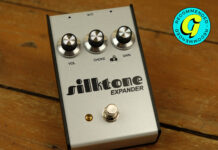
Does It Doom Doomsaw review: A HM-2 on Quaaludes
Does It Doom started out as a YouTube channel: a resource for doom metal-focused guitar lessons and gear demos. In 2020, it branched out into its own pedal brand: slick-looking one-knob units offering circuits favoured by the whole Black Sabbath–Sunn O))) spectrum. So how has the transition from YouTube channel to pedal brand worked out? It’s not always an easy one, but you’ve read the score on this review. Clearly, Does It Doom did something right. Let’s dive into one of its newer offerings, the HM-2-based Doomsaw, and find out exactly what.
READ MORE: Warm Audio Centavo review – a faithful Klone that you won’t mind gigging
The Doomsaw, alongside most other Does It Doom pedals, has been designed in collaboration with Nick Williams, formerly of Dunwich Amplification, now lending his skills to other brands. It’s a reassuring name to see here: Nick already has experience with the HM-2’s topology, and whenever Dunwich Amps took on a circuit, you could be sure it would be sludgier and nastier than any other interpretation out there. But can you even get sludgier and nastier than the Boss HM-2, a pedal already as sludgy and nasty as a fatberg slithering through a London sewer? Let’s find out.
In use
The stock HM-2 is not exactly lacking in low-end, but it doesn’t really put out the kind of sub-bass rumble that can shake years worth of chewing gum loose from your small intestine. For fast death metal playing this is a bonus, as it means you can still actually hear the riffs. But for slow, down-tuned doom, it can fall a little short of creating an all-consuming wall of sound. Hence the Doomsaw’s EQ has been tweaked to widen the scope of the low-end boost, while still retaining that horrific, grinding chainsaw character thanks to a huge scoop and sharp spike in the lower and upper mids respectively.
In line with the other Does It Doom pedals, there’s only one knob to consider on the Doomsaw: Grief, or, more descriptively, gain. This takes the pedal from ‘dirty’ to ‘really, really dirty’ across its sweep. Bass and treble are maxed internally, but for the latest version, there’s also an internal trimpot for output volume. This is handy in case of any gain-staging issues created by the pedal’s massive output but for the situations the Doomsaw will find itself in, a hefty volume bump will most likely be welcome.
Plugging the pedal into an Orange tube head and a guitar in drop F, we’re off to a good start: even the feedback that rings out of our strings seems to emit smoke and drip with motor oil. And hitting a power chord does indeed give us a grainy, ripping grind evocative of horror cinema’s favourite piece of logging equipment. The increase in bass is indeed noticeable: where our stock HM-2 fails to fully amplify the low-end ‘thunk’ of anything below B standard, the Doomsaw has no such issue. The biting high-treble has also been rolled off a little, shifting the whole character of the pedal to be that much darker.
On top of the circuit itself, the build is all well-considered: top-mounted jacks, the tall enclosure, the soft relay-based true-bypass switching and the large Orange/Matamp style knob all lend it an extremely boutique feel, as does the high-relief UV-printed artwork. It even comes with a bunch of extras, including a fabric patch and a sticker of the artwork – which itself is as gloriously cheesy as it is gloriously metal.
The Doomsaw’s single knob might initially strike you as limiting, which, well, it is: whether that’s a positive or a negative is down to your preference. Fans of the other HM-2 sounds (they do exist – it’s all over Loveless, for instance) will be better off finding a normal Boss unit (or a different take on the circuit) that actually lets you control the bass and treble. But single-knob, high gain pedals (think Earthquakers’s Acapulco Gold, or Dunwich’s own Cthulhu fuzz) are common in doom for a reason: they’re a good fit for a genre that requires a balance between of minimalism (only playing a new chord occasionally) and maximalism (amplifier stacks that threaten to cave in the venue floor).
There’s a scene in the excellent Mandy where Nic Cage’s character is murdering evil cultists. Well, there’s quite a few, but in one in particular he gets bored with his homemade axe and decides to take on a dude with a chainsaw. As he’s trying to get the engine started, the cultist takes out his own chainsaw – one that happens to be about two metres long and with an engine that rumbles like a muscle car’s V8. If the stock HM-2 is Nic Cage’s regular ol’ chainsaw, the Doomsaw is the cultist’s: bigger, bassier, and elevating something already impractical to absurd levels of over-the-top grind.
Key Features
PRICE $189
DESCRIPTION HM-2-inspired distortion pedal
CONTROLS Greif (distortion), internal level trimpot
FEATURES True bypass, soft-relay switching, top-mounted in and out jacks
DIMENSIONS 120mm x 66mm x 50mm
CONTACT doesitdoom.com
Like this? Try These
BOSS Wazacraft HM-2 (£149)
KMA Machines Wurm 2 (£169)
Abominable Electronics Throne Torcher ($225)
The post Does It Doom Doomsaw review: A HM-2 on Quaaludes appeared first on Guitar.com | All Things Guitar.
Source: www.guitar-bass.net











